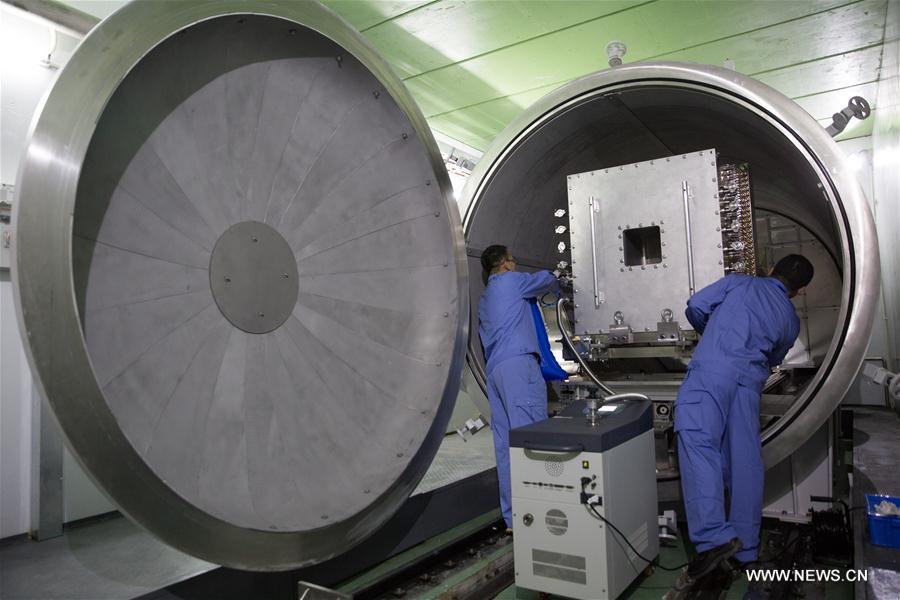

Engineers debug a neutron instrument for the China Spallation Neutron Source (CSNS) in Dongguan, south China's Guangdong Province, Sept. 1, 2017. According to a press conference held by the Institute of High Energy Physics of Chinese Academy of Sciences in Dongguan Friday, a neutron beam was successfully obtained at the CSNS for the first time on Aug. 28, 2017, which marks the completion of the main construction and the start of the test operation phase for the CSNS project, a national large scientific facility. The project should be fully completed and open to domestic and overseas users by 2018 as scheduled. (Xinhua/Jin Liwang)
China has become the latest country to create neutron beams-which can examine subatomic materials without damaging their structure-an advance expected to lead to new discoveries in material science, clean energy and medicine.
The beams were first produced on Aug 28 at the China Spallation Neutron Source in Dongguan, Guangdong province, making China the fourth country in the world, after the United States, United Kingdom and Japan, to have a neutron beam source.
"This is a major milestone for Chinese scientists. The lab will help us solve some of the nation's most difficult scientific issues," said Chen Hesheng, an academician of the Chinese Academy of Sciences and the manager of the project.
"It will also help the Guangdong-Hong Kong-Macao Greater Bay Area to upgrade its industries and support their high-end scientific research and development," Chen said.
The China Spallation Neutron Source cost 1.87 billion yuan ($280 million) and took around six and a half years to build. It will be fully operational next year and Chinese scientists from more than 70 projects and 22 universities have applied to use it. The facility would also be open to foreign researchers, he said.
Neutrons and protons are found at the nucleus, or the core of an atom-the basic building block of materials. While protons have a positive charge, neutrons have no electric charge, and have strong penetrative capability.
As a result, unlike X-rays, whose ionized radiation can rip through the atomic structures of biomaterials like proteins, neutron rays can just pass through the material without damaging the structures, Chen said.
However, some neutrons will hit the atomic nucleus in the material and "bounce" harmlessly away at an angle in a phenomenon called neutron scattering, hence creating the "spallation". Using detectors, scientists can count these scattered neutrons, measure their energies and the angles at which they scatter, and map their final positions.
This way, scientists can glean details about the nature of the examined materials-from its atomic arrangement to movements.
"This will help scientists discover new chemical mechanisms for producing clean energy, new material for more powerful electronics, or create stronger and more durable material for engines," Chen said.
Another promising application is creating new therapies to treat tumors that are difficult to operate on by hand, such as brain tumors, said Fu Shinian, a researcher at the academy's Institute of High Energy Physics.
The Boron Neutron Capture Therapy takes advantage of boron's properties to accurately latch onto cancer cells. Then doctors can shine neutron beams at the tumor, triggering the boron to kill the cancer cells while leaving surrounding cells intact, Fu said.
Despite these promising applications, creating neutron beams is no easy task. In China's neutron source, scientists have to accelerate a group of protons close to the speed of light, use them to smash into a target tungsten block, and knock the neutrons out of the target's atomic nucleus.
Then these neutrons are "sucked" into various branches and channeled into different lab equipment for research, said Chen. All of the equipment used to generate the neutron beams is more than a dozen meters underground, trapping the tiny amount of harmful radiation created in the process.
China's neutron source will be free to the public, only collecting a small fee from companies with special needs. (China Daily)

86-10-68597521 (day)
86-10-68597289 (night)

86-10-68511095 (day)
86-10-68512458 (night)

cas_en@cas.cn

52 Sanlihe Rd., Xicheng District,
Beijing, China (100864)

